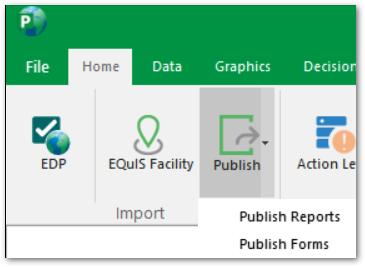Class (*.dll) reports, RDL Reports (*.rdl), SQL Reports (*.sql) and EDD Export formats (*.zip) can be published by Database-Level Security (DLS) users or Application-Level Security (ALS) administrators to the EQuIS Database through the Professional application.
All class reports from .dlls in the EQuIS folder are listed in the EQuIS Professional Open Reports Dialog, regardless of whether these reports have already been published. If the report has already been published to the database, publishing the report again will update the existing report. For guidance on when reports should be republished, click here.
Standard function and procedure reports in the EQuIS Database (e.g,. the v54.analytical_results function) cannot be published; they are already stored in the database (in ST_REPORT and ST_REPORT_PARAMETER). Active Reports and Crosstabs can also be published through their respective interfaces.
Load Report in Report Publisher
1.From the Home ribbon, click Publish Reports under the Publish button for the Report Publisher. The Report Publisher Open File dialog will open. By default, the file filter is set to Other Reports (*.dll) for importing a class report.

2.Select the down-arrow (if necessary) to change the file type filter to RDL Reports (*.rdl), SQL Reports (*.sql) or EDD Export Formats (*.zip).

3.Browse to and select the report file to display the Report Publisher Form with the report(s) defined in the report file. The left pane of the form lists the report(s) in tree view that can be expanded to view the parameters. The right pane of the form shows a Report tab and a Parameters tab for the report or parameter selected in the left pane.
Note: When EDD Export Formats (*.zip) is selected, it will be published immediately (following user prompts) and the Report Publisher Form will open blank. Nothing more is needed to publish the EDD Export formats. |
4.Use the Report Publisher Form to review the New Report and New Parameters columns and update as needed.
a.If the report is new, the Existing Report and Existing Parameters columns will be blank. Otherwise, they will show the information for the existing report. When the report is published, this information will be updated in the database with what is displayed in the New Report and New Parameters columns.
b.The Incoming Report and Incoming Parameters columns display the report and parameter information defined in the loaded report file.
c.If there are differences between the Incoming Parameters and Existing Parameters columns, the affected fields and the parameter and report listing in the left pane of the form will be highlighted.
Publish Report from Report Publisher
1.Make sure the check boxes of the report(s) to be published are checked in the left pane of the Report Publisher Form.
2.Click Publish (Save icon ![]() ).
).
3.The first time Publish is clicked after loading a report in the Report Publisher Form, a pop-up for selecting whether to store the report assembly in the database, will display.
a.Select Yes to store the report assembly in the database. The .dll will be copied into a blob field.
b.Select No to manually copy the report assembly. Copy the report .dll to the Enterprise bin directory for use from Enterprise. To allow access to the report for all Professional users, distribute the .dll to those users to install in their EQuIS Program folder.
Once the option has been selected, that same answer will be used on subsequent publish actions for the same loaded report and the prompt will not appear. Clicking Load and loading a new report or opening a new instance of the Report Publisher Form will cause the prompt to appear again when Publish is clicked.
4.After the report(s) have been published, a confirmation will appear.
5.Relaunch EQuIS Professional to view the newly published reports.